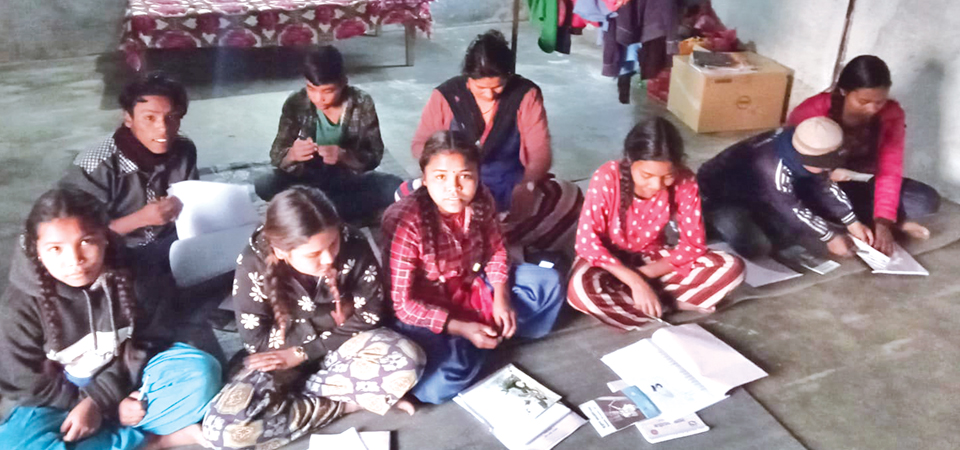A scholar’s bid to revive dying Kusunda language

By Shaurya Kshatri
Kathmandu, Mar. 13: Languages with less than 1000 speakers are categorised as being endangered or moribund. But in the case of the Kusunda language, simply calling it ‘endangered’ is putting it mildly.
According to the National Population Census, only 273 people identified themselves as Kusunda in 2011. Today, as Dhan Bahadur Kusunda, founder of Nepal Kusunda Development Society, claims, there are less than 150 of them scattered across the country in Surkhet, Dang, Tanahun, and Gorkha districts.
The once-native tongue of Nepal’s semi nomadic indigenous tribe, the Kusunda language has been teetering on the brink of extinction for the last 160 years.
The earliest known academic account of the language dates back to the late 1850s, when Brian Hodgson, a British Resident to the Court of Nepal, published a list of 223 Kusunda words in his ‘Comparative Vocabulary of the Languages of the Broken Tribes of Nepal’ (1857).
Even as early as the 19th century, Hodgson had described the tribe as being scanty in numbers and had even predicted its demise: “The lapse of a few generations will probably see the total extinction of the Chepangs and Kusunda.”
In 1985, the Ethnologue -- an annual reference publication that catalogues the world’s languages, declared the extinction of the Kusunda language.
But despite the Ethnologue’s claim, two fluent Kusunda speakers were discovered in 2004, and the present grammar is based on almost three- months of intensive research with them.
The two Kusundas were late Gyani Maya Sen Kusunda -- a pioneering figure in Kusunda preservation and Kamala Khatri. Gyani Maya Sen Kusunda passed away on January 25, 2020 leaving 49-year-old Khatri as the last remaining Kusunda speaker to shoulder the fate of a dying culture and its unique language. Originally from a village of Sakhi in Rolpa, Kamala also shoulders the responsibility of her three sons, a daughter, a granddaughter and her 75-year-old husband.
But lifting some of the burden off Khatri’s shoulders in reviving the moribund language is researcher, journalist Uday Raj Ale, who also published Kusunda Tribe and Dictionary back in 2017. Although a non-native, Ale is the only other individual capable of conversing and understanding Kusunda apart from Khatri.
In January 2019, the Language Commission in a bid to resuscitate the dying language began conducting language classes assigning late Gyani Maiya and
Khatri as the resource persons with Ale as the facilitator and teacher. They were each offered a language stipend of Rs 3,000 a month. The sessions were to be conducted regularly but after a couple of weeks the classes were discontinued.
Since then a lot has passed in between -- from the demise of Gyani Maiya to the outbreak of a global pandemic. “Almost two years hence, we have finally begun the classes with me and Kamalaji spearheading the classrooms,” said Ale.
Under the initiative of the Nepal Kusunda Development Society and Language Commission, classes
have begun at Dharna Mahendra Secondary School, Dharna and at a girl’s hostel in Dang’s Supailakhuti.
The language Commission has shown promise towards preserving endangered languages. While previously it had offered no more than Rs. 3,000 per month as salary for Kamala Khatri, this time around she has been offered Rs. 14,000 per month, which has been helpful in meeting her household expenses.
Today, Ale teaches 11 students at the girl’s hostel while Kamala caters to around 11 to 12 students at Dharna. Most participants are secondary-level students.
Based entirely on oral tradition, the language doesn’t have a text of its own, making the archiving and preservation part all the more difficult. As a result of this, Ale through his research and study has published a text book called Kusunda Gipan, which is replete with word recognitions, word usage and sentence formation.
“Ale’s contribution has become key in re-establishing the Kusunda class,” stated Dhan Bahadur Kusunda.
Participation of younger generations has been particularly encouraging. The older generation of Kusundas have mostly forgotten their native language and are now incapable of learning them. However, as Ale claims, their young sons, daughters and grandchildren are increasingly showing interest.
One among them is 15-year-old Hema, granddaughter of 86-year-old Kusunda shaman Lil Bahadur Kusunda. “Lil Bahadur is a healer, who as a child grew up in the forest before relocating to villages after marriage,” explained Ale. Currently, studying in Grade IX, Hema, although detached from her grandfather’s hunter-gatherer lifestyle, is keen to preserve her ancestral culture and language.
“Lil Bahadur has forgotten the Kusunda language but Hema, on the other hand, is one of the brightest students who has made significant progress,” informed Ale. Apart from speaking, Hema is also capable of singing and composing songs in Kusunda.
“While it might be too ambitious to think that Kusunda language will ever be revived, it’s comforting to see young Kusundas taking interest in their language and culture,” expressed Ale.
Recent News

Do not make expressions casting dout on election: EC
14 Apr, 2022
CM Bhatta says may New Year 2079 BS inspire positive thinking
14 Apr, 2022
Three new cases, 44 recoveries in 24 hours
14 Apr, 2022
689 climbers of 84 teams so far acquire permits for climbing various peaks this spring season
14 Apr, 2022
How the rising cost of living crisis is impacting Nepal
14 Apr, 2022
US military confirms an interstellar meteor collided with Earth
14 Apr, 2022
Valneva Covid vaccine approved for use in UK
14 Apr, 2022
Chair Prachanda highlights need of unity among Maoist, Communist forces
14 Apr, 2022
Ranbir Kapoor and Alia Bhatt: Bollywood toasts star couple on wedding
14 Apr, 2022
President Bhandari confers decorations (Photo Feature)
14 Apr, 2022










